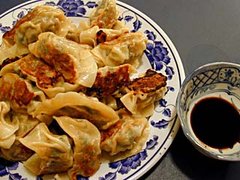Jiaozi
|
|
Jiaozi.jpg
Jiaozi (Template:Zh-stpw; Cantonese: gau35 dzi35;) or gyōza is a Chinese dumpling, widely popular in Korea and Japan as well as outside of Northeast Asia. This dumpling consists of a ground meat or vegetable filling that is wrapped into a thinly rolled piece of dough. The jiaozi should not be confused with the wonton: the jiaozi dumpling has a thicker skin, is shaped slighly like a tiny turnover, and is usually eaten with a soy-vinegar dipping sauce (and/or hot chili sauce); while a wonton has a thinner skin, is shaped like a comet, and is usually served in broth.
| Contents |
Chinese version of the dumpling
Chinese dumplings may be divided into various subclasses. Steamed dumplings are called zhēngjiǎo (蒸餃). Boiled dumplings are called "water dumplings" or shuǐjiǎo (水餃). Fried dumplings are called "potstickers" or guōtiē (鍋貼). Dumplings that use egg rather than dough to wrap the filling are called "egg dumplings" or dànjiǎo (蛋餃).
Dumplings are one of the major foods eaten during the Chinese New Year. The shape of a dumpling resembles a Chinese golden tael; therefore they symbolize good fortune in the coming year. Families have dumpling wrapping parties just before New Year where they slaughter the choicest livestock, grind the meat, wrap the meat into dumplings, and freeze them outside with the help of the freezing weather. Then they boil and serve them for the Chinese New Year feast.
For the New Year's feast, one of the dumplings is deliberately wrapped with a coin embedded in the filling; another is wrapped with a date embedded in the filling. Whoever gets the dumpling with a coin supposedly will get good fortune for the year. A female who gets the dumpling with a date will be supposedly be blessed with giving birth to a child for that year.
Popular dumpling meat fillings include mutton, pork, beef, fish, and shrimp which are usually mixed with minced vegetables. Popular vegetable fillings include cabbage, scallion, and Chinese chives. Dumplings are eaten with a soy sauce-based dipping sauce that may include garlic, ginger, wine, hot sauce, and vinegar.
Japanese version of the dumpling
The Japanese word gyōza was derived from the reading of 餃子 (jiǎozi in Mandarin Chinese) in the Shandong Chinese dialect and is written with the same characters.
The most common recipe found in Japan is a mixture of minced pork, cabbage, and nira (Garlic chives), seasoned with soy sauce, rice vinegar and sesame oil, wrapped into thinly rolled piece of dough.
Gyōza shops can be found throughout Japan, but more commonly they are sold as a side dish in ramen restaurants. The most popular preparation method is called yaki-gyōza (焼き餃子) where the dumpling is first fried on the backside, later water is added. Sealed with a lid the upper part of the gyōza is steamed until the water has evaporated. Other popular methods include boiling (水餃子; Sui-gyōza) and deep frying (揚げ餃子; Age-gyōza). Dipped into a sauce of rice vinegar, soy sauce and/or spiced oil, they are best enjoyed while still steaming hot.
Korean version of the dumpling
The Korean name of the dish is mandu (만두), and is more or less the same as the Japanese and Chinese versions depicted above. Popular ingredients for Korean dumplings include pork, vegetables, clear rice noodles, and kimchi.
See also
External links
- Script comparison (http://www.cjvlang.com/Writing/writsys/signs/gyoza.html)fr:jiaozi

